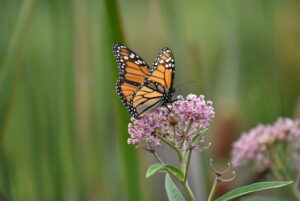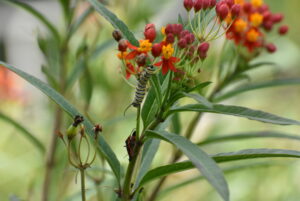By Bernheim
 Though we are only just past summer’s mid-point, revitalizing gusts of cool air are returning to the lush landscape of the Edible Garden. Chilly mornings and moderate temperatures are a welcome relief for staff and visitors alike. During the summer months, it is generally preferable to accomplish tasks quickly during the coolest parts of the day, in order to avoid severe exhaustion during the hottest hours. While this method can be effective, it becomes easy to overlook the smaller details of the garden ecosystem. I try to remind myself to kiss the ground with my footsteps, listen to the bird songs, and always remember the garden isn’t just a place for food production and education; it’s a living source of life for countless creatures great and small. Many of these creatures depend heavily on specific conditions to survive and if these conditions aren’t met, even a lush garden could be a barren wasteland.
Though we are only just past summer’s mid-point, revitalizing gusts of cool air are returning to the lush landscape of the Edible Garden. Chilly mornings and moderate temperatures are a welcome relief for staff and visitors alike. During the summer months, it is generally preferable to accomplish tasks quickly during the coolest parts of the day, in order to avoid severe exhaustion during the hottest hours. While this method can be effective, it becomes easy to overlook the smaller details of the garden ecosystem. I try to remind myself to kiss the ground with my footsteps, listen to the bird songs, and always remember the garden isn’t just a place for food production and education; it’s a living source of life for countless creatures great and small. Many of these creatures depend heavily on specific conditions to survive and if these conditions aren’t met, even a lush garden could be a barren wasteland.
 As the biodiversity of the Edible Garden increases each year, it’s crucial to introduce new plants to this environment. This year we added butterfly weed, Asclepias tuberosa, a native perennial that monarch butterflies, Danaus plexippus adore. For its second year we also planted tropical milkweed, Asclepias curassavica, and we are astonished to see swamp milkweed, Asclepias incarnata that we planted 3 years ago has finally bloom for the first time! Each of these plants are a food source for the monarch butterfly larvae and are crucial to its survival. Along with the perennials planted this year, we also added a variety of annuals to our display of vibrant color. Homestead purple, Verbena canadensis has thrived this year, and seems to be a particular favorite of snowberry clearwing, Hemaris diffinis (also known as flying lobster). All of these plants and insects, great and small, contribute to the self-sustaining balance of a diverse garden.
As the biodiversity of the Edible Garden increases each year, it’s crucial to introduce new plants to this environment. This year we added butterfly weed, Asclepias tuberosa, a native perennial that monarch butterflies, Danaus plexippus adore. For its second year we also planted tropical milkweed, Asclepias curassavica, and we are astonished to see swamp milkweed, Asclepias incarnata that we planted 3 years ago has finally bloom for the first time! Each of these plants are a food source for the monarch butterfly larvae and are crucial to its survival. Along with the perennials planted this year, we also added a variety of annuals to our display of vibrant color. Homestead purple, Verbena canadensis has thrived this year, and seems to be a particular favorite of snowberry clearwing, Hemaris diffinis (also known as flying lobster). All of these plants and insects, great and small, contribute to the self-sustaining balance of a diverse garden.
Dedicating time to pay attention to details we easily overlook helps demonstrate that we are all a vital part of cycle to sustain life. Gardeners and nature lovers observe the creative and destructive elements of the natural world that emphazise the overall importance of everything involved. The more we understand our environment, the closer we come to better understanding ourselves and how we not only fit into this cycle, but also how we can help it flourish.

